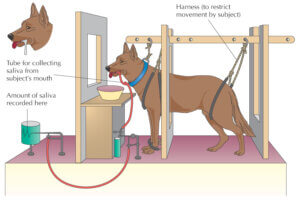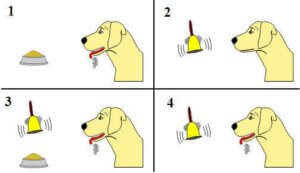Ivan Pavlov and Positive Reinforcement in Dogs

Positive reinforcement is starting to gain a lot of popularity among dog owners and handlers. We now know how our dog reacts to external stimuli thanks to the research of the Russian psychologist Ivan Pavlov, winner of the Nobel Prize for Medicine in 1904.
Ivan Pavlov and positive reinforcement
Around the year 1890, the Russian psychologist Ivan Pavlov focused on the study of salivation in dogs. Specifically, he studied the causes that provoke this physiological response in the animal.
This phenomenon caught his attention because he realized that it took place every time his own dog saw that he entered the room, regardless of whether he had food in his hand.
Pavlov’s study was based on the fact that there were certain things a dog didn’t need to be trained on, since it responded instinctively. Animals, for example, unconsciously salivate in the proximity of prey or food.

His study focused on experiments —considered cruel today— that have helped us understand dogs’ unconscious responses to stimuli. Consequently, we’re now able to predict how they’ll respond, and apply better training techniques.
Pavlov’s conditioned reflex and its impact
Behavioral studies call an animal’s response to a stimulus “unconditioned reflex” – a response without a previous action having provoked it, nor a previous learning process having led it to react in that way.
Pavlov demonstrated the existence of this unconditioned response. Therefore, he put a bowl of food in front of a dog and measured the amount of salivary secretions. The result allowed him to realize that the same response could be triggered by creating new associations.
For example, in the case of food, the dog began to associate Pavlov’s laboratory assistant with the arrival of food, which led to a change in behavior.
The assistant with whom he had associated the food was a “neutral stimulus” that he had related to something positive. Pavlov did the same with a bell, which he rang each time food arrived. Even though sometimes he didn’t give anything to the dog, the salivary response continued.

Thus, he discovered the “conditioned reflex”. This is the capacity to trigger an animal’s response – which would normally occur unconsciously – with an element or action that interests us.
The advantages of positive reinforcement over negative reinforcement
The growing popularity of positive dog education is due to the fact that it’s a good way to teach your dog to behave correctly without making it feel punished or uncomfortable.
Anyway, for each type of dog and each type of keeper, there are different options that can be perfectly valid. Negative reinforcement, also called Alpha methods, is usually used for dominant dogs. Thus, it’s based on techniques of domination by the keeper.
Negative reinforcement is based on making the pet identify what it’s doing wrong, so that it can rectify it. As a result, owners can use newspapers to scare the animal, special leashes, tackling techniques (if the dog is very aggressive), etc.
If you have a medium-sized dog as a companion animal, positive reinforcement is the most effective option. On the contrary, if your dog is big and dominant and you’re thinking about it acting as a guardian, then there are more options that you can consult with a professional.
Positive reinforcement is starting to gain a lot of popularity among dog owners and handlers. We now know how our dog reacts to external stimuli thanks to the research of the Russian psychologist Ivan Pavlov, winner of the Nobel Prize for Medicine in 1904.
Ivan Pavlov and positive reinforcement
Around the year 1890, the Russian psychologist Ivan Pavlov focused on the study of salivation in dogs. Specifically, he studied the causes that provoke this physiological response in the animal.
This phenomenon caught his attention because he realized that it took place every time his own dog saw that he entered the room, regardless of whether he had food in his hand.
Pavlov’s study was based on the fact that there were certain things a dog didn’t need to be trained on, since it responded instinctively. Animals, for example, unconsciously salivate in the proximity of prey or food.

His study focused on experiments —considered cruel today— that have helped us understand dogs’ unconscious responses to stimuli. Consequently, we’re now able to predict how they’ll respond, and apply better training techniques.
Pavlov’s conditioned reflex and its impact
Behavioral studies call an animal’s response to a stimulus “unconditioned reflex” – a response without a previous action having provoked it, nor a previous learning process having led it to react in that way.
Pavlov demonstrated the existence of this unconditioned response. Therefore, he put a bowl of food in front of a dog and measured the amount of salivary secretions. The result allowed him to realize that the same response could be triggered by creating new associations.
For example, in the case of food, the dog began to associate Pavlov’s laboratory assistant with the arrival of food, which led to a change in behavior.
The assistant with whom he had associated the food was a “neutral stimulus” that he had related to something positive. Pavlov did the same with a bell, which he rang each time food arrived. Even though sometimes he didn’t give anything to the dog, the salivary response continued.

Thus, he discovered the “conditioned reflex”. This is the capacity to trigger an animal’s response – which would normally occur unconsciously – with an element or action that interests us.
The advantages of positive reinforcement over negative reinforcement
The growing popularity of positive dog education is due to the fact that it’s a good way to teach your dog to behave correctly without making it feel punished or uncomfortable.
Anyway, for each type of dog and each type of keeper, there are different options that can be perfectly valid. Negative reinforcement, also called Alpha methods, is usually used for dominant dogs. Thus, it’s based on techniques of domination by the keeper.
Negative reinforcement is based on making the pet identify what it’s doing wrong, so that it can rectify it. As a result, owners can use newspapers to scare the animal, special leashes, tackling techniques (if the dog is very aggressive), etc.
If you have a medium-sized dog as a companion animal, positive reinforcement is the most effective option. On the contrary, if your dog is big and dominant and you’re thinking about it acting as a guardian, then there are more options that you can consult with a professional.
This text is provided for informational purposes only and does not replace consultation with a professional. If in doubt, consult your specialist.








